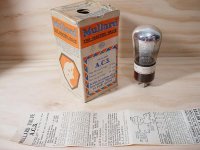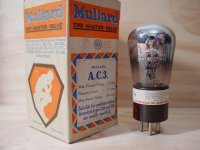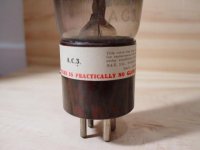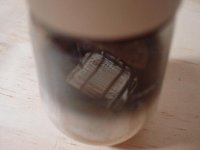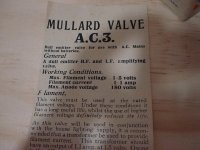Yes I have noticed the same issue in terms of the stepped attenuators and switches on the chassis, I don't find this particularly annoying and in my case with music playing the little "boings" are not audible.
Mounting the tube sockets on an isolated sub-chassis should help a lot. There are elastomeric bushings used to mount cd mechanisms in players which are quite suitable for this purpose. Just google for the same and get a large selection of different modulus bushings to try. Springs and bushings are also often used and can be quite successful.
Note that switches and stepped attenuators can also be mounted on isolated sub-chassis as well.
Using a fairly heavy aluminum chassis with wood end pieces and a thick aluminum front panel helps a lot.. Adding mass to the chassis by using a piece of resiliant flooring on top of the chassis adds interest, mass and deadening to the top.
Another poster made the comment that the 26 tube favored voice at the expense of everything else. This has not been my experience with good plate to line transformers. (In my case HA-133) Based on long experience reproducing voice well is one of the hardest things to do in hifi, most of us know the human voice well, and small system colorations that are not that noticeable on some instruments (particularly if you don't go to live acoustic music concerts) are often very noticeable on voice.
The 26 and the 01 have high rp's for transformer coupling given that 15 - 20K SE plate to line transformers are about the limit for practicality, particularly if you need any gain at all. OTOH the 12A/112A has an rp of right around 5K which should make it an excellent match to most of the existing transformers.
I have not noted large variations in sound quality between comparable 01 and 26 based pre-amplifiers. Saying one tube is inherently better than the other is meaningless unless you have a very large sample of each. I have about 12 pairs of 26's and there is probably as much variation in sonics between brands and vintages of these are there are between the 01 and 26. One of my particular favorites is the CECO 226, another I like is the early ST base Sylvania 26 in the green box (about 1931). All I have tried have been at least decent if they were not clapped out.
I also have 12a's which I have not yet tried, but their lower rp should result in better bass extension and less LF distortion, at the possible expense of poorer top end extension depending on leakage inductance in your plate to line transformer.
Mounting the tube sockets on an isolated sub-chassis should help a lot. There are elastomeric bushings used to mount cd mechanisms in players which are quite suitable for this purpose. Just google for the same and get a large selection of different modulus bushings to try. Springs and bushings are also often used and can be quite successful.
Note that switches and stepped attenuators can also be mounted on isolated sub-chassis as well.
Using a fairly heavy aluminum chassis with wood end pieces and a thick aluminum front panel helps a lot.. Adding mass to the chassis by using a piece of resiliant flooring on top of the chassis adds interest, mass and deadening to the top.
Another poster made the comment that the 26 tube favored voice at the expense of everything else. This has not been my experience with good plate to line transformers. (In my case HA-133) Based on long experience reproducing voice well is one of the hardest things to do in hifi, most of us know the human voice well, and small system colorations that are not that noticeable on some instruments (particularly if you don't go to live acoustic music concerts) are often very noticeable on voice.
The 26 and the 01 have high rp's for transformer coupling given that 15 - 20K SE plate to line transformers are about the limit for practicality, particularly if you need any gain at all. OTOH the 12A/112A has an rp of right around 5K which should make it an excellent match to most of the existing transformers.
I have not noted large variations in sound quality between comparable 01 and 26 based pre-amplifiers. Saying one tube is inherently better than the other is meaningless unless you have a very large sample of each. I have about 12 pairs of 26's and there is probably as much variation in sonics between brands and vintages of these are there are between the 01 and 26. One of my particular favorites is the CECO 226, another I like is the early ST base Sylvania 26 in the green box (about 1931). All I have tried have been at least decent if they were not clapped out.
I also have 12a's which I have not yet tried, but their lower rp should result in better bass extension and less LF distortion, at the possible expense of poorer top end extension depending on leakage inductance in your plate to line transformer.
Has anyone tried Mullard A.C.3?
These are British alternative of UX226 and I'm about to give these a try... They have wood-patterned bases, manufactured at 1920's.
Apparently the rarest member of 26 family I think (These is no data on google about A.C.3)...
I'll post the results once the project is finished
These are British alternative of UX226 and I'm about to give these a try... They have wood-patterned bases, manufactured at 1920's.
Apparently the rarest member of 26 family I think (These is no data on google about A.C.3)...
I'll post the results once the project is finished
jamesjung21 said:Has anyone tried Mullard A.C.3?
These are British alternative of UX226 and I'm about to give these a try... They have wood-patterned bases, manufactured at 1920's.
Apparently the rarest member of 26 family I think (These is no data on google about A.C.3)...
I'll post the results once the project is finished
Tell us some more about them, please.
Do they share the filament specs of the 26 or do they have "normal" filaments like the 12A? Do you have any data? pictures?
I agree with etalon90 in preferring the 01a to the 26. It's just a case of personal preference - I like a lighter drier sound with more delicate treble. I find the 26 just a bit warm, though the detail is all there. Others prefer warm, and find DHTs like the 01a thin sounding.
My chassis is alu 2U extrusions front and back, wood sides and 4mm alu top plates. I have a modular construction with 5 top plates, so they don't really iinteract and 4mm is pretty non-resonant. With all this I found little trouble with microphonics. Worst was 31. 26 was fine. Andy
My chassis is alu 2U extrusions front and back, wood sides and 4mm alu top plates. I have a modular construction with 5 top plates, so they don't really iinteract and 4mm is pretty non-resonant. With all this I found little trouble with microphonics. Worst was 31. 26 was fine. Andy
These is no data on
Oh dear... Terrible spelling mistake... it happens whenever I write something on hurry before I go to bed

I'll post some photos of box, datasheet, and the tube tonight
The spec of filament is 1.5V @ 1.1A...
Looks very similar to 26, 1.5V filament
It actually is a British version of 26. It even says so on the box...
I personally have never seen this being on eBay before, although I do often come across some rare American members of 26 like ones from Arcturus and CeCo...
Cheers,
James
Here are photos of A.C.3, Carton, Wood-pattern base, and the plate structure (It's a mesh plate).
The carton design and Mullard's logo shows you what Mullard tubes originally looked like back in 1920s, quite different to the one that we normally come across these days.
The carton design and Mullard's logo shows you what Mullard tubes originally looked like back in 1920s, quite different to the one that we normally come across these days.
Attachments
- Status
- This old topic is closed. If you want to reopen this topic, contact a moderator using the "Report Post" button.
- Home
- Amplifiers
- Tubes / Valves
- 10Y, 26, 27 and 45: relative microphonics
